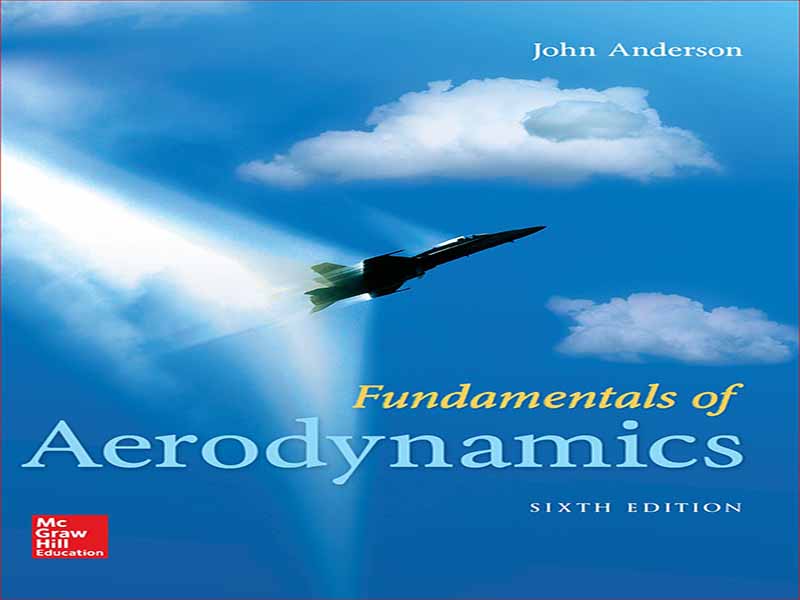- عنوان: Fundamentals of Aerodynamics
- نویسنده: John D. Anderson, Jr.
- حوزه: آیرودینامیک
- سال انتشار: 2017
- تعداد صفحه: 1153
- زبان اصلی انگلیسی
- نوع فایل: pdf
- حجم فایل: 27.2 مگابایت
این کتاب طبق سنت نسخههای قبلی دنبال میشود: برای دانشآموزان است – خواندن، درک و لذت بردن. آگاهانه به سبکی واضح، غیررسمی و مستقیم نوشته شده است تا با خواننده صحبت کند و علاقه فوری او را به رشته چالش برانگیز و در عین حال زیبای آیرودینامیک جلب کند. توضیح هر موضوع با دقت ساخته شده است تا برای خواننده معنا پیدا کند. علاوه بر این، ساختار هر فصل بسیار سازماندهی شده است تا خواننده را از اینکه کجا هستیم، کجا بودیم و به کجا می رویم آگاه نگه دارد. غالباً دانشآموز آیرودینامیک آنچه را که میخواهد انجام دهد، از دست میدهد. برای جلوگیری از این امر، سعی میکنم خواننده را همیشه در جریان قصدم قرار دهم. به عنوان مثال، جعبه های پیش نمایش در ابتدای هر فصل معرفی می شوند. این بخشهای کوتاه که به معنای واقعی کلمه در جعبهها تنظیم شدهاند، به خواننده به زبانی ساده اطلاع میدهند که از هر فصل چه انتظاری داشته باشد و چرا مطالب مهم و هیجانانگیز است. آنها در درجه اول انگیزشی هستند. آنها به تشویق خواننده کمک می کنند تا واقعاً از خواندن این فصل لذت ببرند، بنابراین روند آموزشی را تقویت می کنند. علاوه بر این، هر فصل شامل یک نقشه راه است – یک بلوک دیاگرام که برای آگاه نگه داشتن خواننده از جریان مناسب ایده ها و مفاهیم طراحی شده است. استفاده از جعبه های پیش نمایش و نقشه های راه فصل از ویژگی های منحصر به فرد این کتاب است. همچنین، برای کمک به سازماندهی افکار خواننده، بخش های خلاصه ویژه ای در پایان بیشتر فصل ها وجود دارد. مطالب این کتاب در سطح دانش آموزان و دانشجویان ارشد در رشته هوافضا یا مهندسی مکانیک است. هیچ دانش قبلی از دینامیک سیالات به طور کلی، یا آیرودینامیک به طور خاص را فرض نمی کند. فرض بر این است که با حساب دیفرانسیل و انتگرال، و همچنین پیشینه معمول فیزیک که برای اکثر دانشجویان علوم و مهندسی مشترک است، آشنا باشید. همچنین، زبان تحلیل برداری به صورت آزادانه استفاده می شود. مروری فشرده از عناصر ضروری جبر برداری و حساب برداری در فصل 2 به گونه ای ارائه شده است که می تواند خواننده را آموزش دهد یا تازه کند، هر چه ممکن است برای هر فرد باشد. این کتاب برای دوره یک ساله آیرودینامیک طراحی شده است. فصل های 1 تا 6 یک ترم جامد را تشکیل می دهند که بر جریان غیر لزج و تراکم ناپذیر تأکید دارد. فصل های 7 تا 14 یک ترم دوم را اشغال می کنند که به جریان تراکم ناپذیر و غیر لزج می پردازد. در نهایت، فصلهای 15 تا 20 برخی از عناصر اساسی جریان چسبناک را معرفی میکنند، که عمدتاً به عنوان تضاد و مقایسه با جریانهای غیر لزج در کل متن مورد بررسی قرار میگیرند. با این حال، بخشهای خاصی در مورد جریان ویسکوز خیلی زودتر در کتاب اضافه شده است تا به خواننده ایده دهد که چگونه نتایج غیر چسبنده تحت تأثیر اصطکاک تعدیل میشوند. این کار با افزودن بخشهای جریان ویسکوز مستقل در انتهای فصلهای مختلف انجام میشود که بهگونهای نوشته و قرار داده میشوند که در جریان بحث جریان غیر لزج دخالتی نداشته باشند، اما برای تکمیل بحث وجود دارند. به عنوان مثال، در پایان فصل 4 در مورد ایرفویل های جریان غیرلرزنده تراکم ناپذیر، یک بخش جریان چسبناک وجود دارد که به پیش بینی کشش اصطکاک پوست در چنین ایرفویل ها می پردازد. یک بخش جریان چسبناک مشابه در پایان فصل 12 به کشش اصطکاک در ایرفویل های با سرعت بالا می پردازد. در پایان فصلهای مربوط به امواج ضربهای و جریانهای نازل، بخشهای جریان چسبناک در مورد برهمکنشهای موج ضربه/لایه مرزی وجود دارد. و غیره.
This book follows in the same tradition as the previous editions: it is for students—to be read, understood, and enjoyed. It is consciously written in a clear, informal, and direct style to talk to the reader and gain his or her immediate interest in the challenging and yet beautiful discipline of aerodynamics. The explanation of each topic is carefully constructed to make sense to the reader. Moreover, the structure of each chapter is highly organized in order to keep the reader aware of where we are, where we were, and where we are going. Too frequently the student of aerodynamics loses sight of what is trying to be accomplished; to avoid this, I attempt to keep the reader informed of my intent at all times. For example, preview boxes are introduced at the beginning of each chapter. These short sections, literally set in boxes, inform the reader in plain language what to expect from each chapter and why the material is important and exciting. They are primarily motivational; they help to encourage the reader to actually enjoy reading the chapter, therefore enhancing the educational process. In addition, each chapter contains a road map—a block diagram designed to keep the reader well aware of the proper flow of ideas and concepts. The use of preview boxes and chapter road maps are unique features of this book. Also, to help organize the reader’s thoughts, there are special summary sections at the end of most chapters. The material in this book is at the level of college juniors and seniors in aerospace or mechanical engineering. It assumes no prior knowledge of fluid dynamics in general, or aerodynamics in particular. It does assume a familiarity with differential and integral calculus, as well as the usual physics background common to most students of science and engineering. Also, the language of vector analysis is used liberally; a compact review of the necessary elements of vector algebra and vector calculus is given in Chapter 2 in such a fashion that it can either educate or refresh the reader, whatever may be the case for each individual. This book is designed for a one-year course in aerodynamics. Chapters 1 to 6 constitute a solid semester emphasizing inviscid, incompressible flow. Chapters 7 to 14 occupy a second semester dealing with inviscid, compressible flow. Finally, Chapters 15 to 20 introduce some basic elements of viscous flow, mainly to serve as a contrast to and comparison with the inviscid flows treated throughout the bulk of the text. Specific sections on viscous flow, however, have been added much earlier in the book in order to give the reader some idea of how the inviscid results are tempered by the influence of friction. This is done by adding self-contained viscous flow sections at the end of various chapters, written and placed in such a way that they do not interfere with the flow of the inviscid flow discussion, but are there to complement the discussion. For example, at the end of Chapter 4 on incompressible inviscid flowover airfoils, there is a viscous flowsection that deals with the prediction of skin friction drag on such airfoils. A similar viscous flow section at the end of Chapter 12 deals with friction drag on high-speed airfoils. At the end of the chapters on shock waves and nozzle flows, there are viscous flow sections on shock wave/boundary-layer interactions. And so forth.
این کتاب را میتوانید بصورت رایگان از لینک زیر دانلود نمایید.
Download: Fundamentals of Aerodynamics




































نظرات کاربران